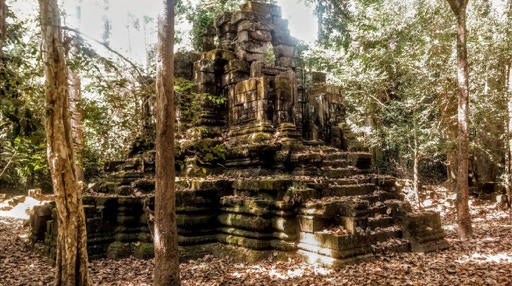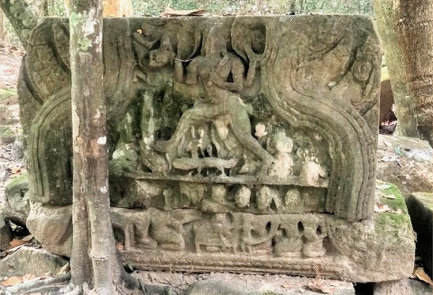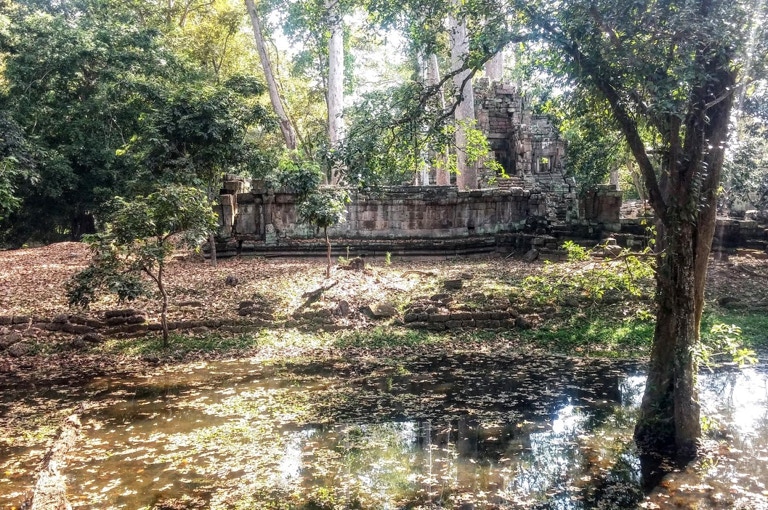
MANGALARTHA
(1295)

MANGALARTHA
(1295)
Mangalartha is the last dated, stone temple to be built at Angkor, a modest shrine following the classic, pancharatha, cruciform Khmer model on a high base, though not comparable with those at Pre Rup or Ta Keo or even those of Temples T and X at Preah Pithu. It is located in what is today forest, just south of the road from the Victory Square to Thommanon to the east. An inscription notes, with usual Khmer punctiliousness, that its god "was brought to life on Thursday, the 28th of April, 1295 at 8:45 AM.” The temple was dedicated to a brahmin scholar, Jayamangalartha, who lived to be 104 and thus must have been among the last links to the centuries-long Hindu traditions behind the great Angkorian temples, including the devaraja cult. He was also Jayavarman VIII's guru or spiritual advisor and presumably a motive force behind that monarch's Hindu restorationist crusade. The last Sanskrit inscription at Angkor is dated 1327 and probably marks the permanent ascendancy of Theravada Buddhism with its Pali-language canon as the national religion.
The temple, unhappily, is distinguished only by its evidence of a precipitous decline from the earlier achievements of Khmer architecture, including Jayavarman VII’s (1181-1220) comparatively recent and unprecedented building campaign. Mangalartha provides a sobering reminder of how quickly the cultural development of seven centuries can be lost. The temple shares the same perfunctory execution as the nearby Prasats Suor Prat, suggesting its builders could barely summon the ability or interest to make a plausible counterfeit of a classic Khmer shrine.
After Mangalaratha, there were no more stone buildings at Angkor (with the possible exception of Temple X at Preah Pithu.) With the ascendancy of Theravada Buddhism a different architectural idiom was adopted, strongly influenced by the Thai and Lanna wat, as well as indigenous, wooden vernacular structures, always practiced at Angkor. A wat usually consists of !) a gable-roofed ubusot or ordination hall, 2) a similar wihan or image hall 3) a pyramidal-roofed, free-standing mondop, derived from the mandapa, 4) an elevated ho trai or library and 5) a stupa, as well as other structures, a bell tower, dormitories, etc. The stupa, chedi or zedi, was the part of subsequent Thai and Cambodian wats which not only retrained an element of the Khmer prasat and shikhara, the basis of the "temple mountain," but developed it with great originality. Stupas are solid reliquaries set on a square, redented or circular base, originally hemispheric, like those at Sanchi and Anuradhapura, or conic, like the Baw-baw-gyi at Sri Ksetra, the Bu Phaya at Bagan and, of course, the Bayon (though a temple, not a stupa.) When Theravada Buddhism reached Thailand and Cambodia in the 13th Century, stupas took their form from the tiered shikharas of Khmer prasats, for example, Wat Si Sawai at Sukhothai or Wat Maha That at Ayutthaya. Eventually, pagodas adopted the familiar bell-shape profile, a double convex-concave curve tapering to a tall finial or hti, exemplified by such notable zedi as the Shwezigon at Bagan and the Shwedagon in Yangon.
On the ground beside the now missing shikhara at Mangalartha lies among the last and least distinguished ediments to have been carved at Angkor, so precipitous was the decline in Khmer artisanship over the 13th Century. This pediment's tribute-lobed torana arch has been reduced to a drooping garland with a few limp leaves clinging to it like a withered memory of summer. The figure of Vishnu, the temple's tutelary deity, is gigantic, not just because the particular scene demands it but, one suspects, because it filled the maximum space with the minimum effort. The pediment portrays a myth, first mentioned in the Rig Veda, in which Vishnu, still a minor deity,(mentioned in only five of its 1028 hymns,) already plays his role as the "preserver" of dharma or divine law on earth, through his (ten avatars or dashavatara, his descents to earth and incarnation as a mortal being, detailed in appendix VI.) In this one respect, at least, he more resembles a fertility deity, like Osiris, Adonis or Christ, than Shiva, who never experiences death. In the so-called "phylogenic interpretation" of Vishnu's dashavatara the god recapitulates evolution becoming the ideal king, Rama, the ideal human, Krishna, (and sometimes a co-opted Buddha,) before his tenth incarnation as Kalki, the horseman of the apocalypse, where he seems to assume Shiva's role as destroyer of a universe, utterly devoid of dharma and hence Brahman, ultimate reality.

TRIVIKRAMA, PEDIMENT, MANGALARTHA (1295)
In the myth depicted here, Mahabali or Bali, king of the asuras, had illicitly acquired immortality by drinking amrita at the time of the Samudra Manthan, "The Churning of the Ocean of Milk," and used this to impose his power over the entire earth and heaven. Vishnu, the guarantor of order on the earth, was approached by the desperate devas for help and assumed his fifth avatar, Vamana, a dwarf, his first human incarnation, albeit in a diminutive and "imperfect" form. In this guise, Vishnu appeared before the tyrant as a monk or brahmin and begged one request: that he be granted as much land as he could cover in three steps. The arrogant king agreed to what seemed a foolish boon, especially for a dwarf. Vishnu then grew to immense size, covering the earth with his first step, and the air or heavens with his second. Mahabali, recognizing that the dwarf was, in fact, the god, humbly offered his own head for the third step. Vishnu, in some versions of the myth, then trampled the king to the bottom of the sea, where he reigned eternally as the king of patala, the netherworld.
The two registers, insofar as they can be distinguished, presumably show denizens of the three worlds (which at this point in the myth excludes the underworld.) In the lower register, representing the terrestrial plane, is a row of the god's devotees, including apsaras, a woman with a child (one hopes not a fallen apsara) at center, a man and a woman on a undersized mount (an impoverished Shiva and Parvati on Nandi, an Umamaheshwar,) an odd figure who might represent Vishnu's own mount, Garuda, and at right a horse, perhaps prefiguring Kalki. In the upper register, birds hover and the god’s signature lotus or padma twines around the god’s feet as he walks on air. His four arms presumably bear his attributes, though the artist has clearly not been up to this admittedly daunting anatomical challenge. Vishnu's raised proper right hand probably held his war discus or chakra, now just a round outline, while his lower hand held a conch, here flattened to a kazoo, to sound the primal tri-syllable A-U-M which will reverberate order throughout the universe. On his proper right, part of his gadda or mace (or the arm holding it) is visible, while at his own level a figure, perhaps Mahabali, kneels, though not where the god can step on him; behind, a figure appears to strike him instead. This king's architectural significance lies solely in having given his name to Mahabalipuram (Mamallapuram) site of the Pancha Rathas and “The Descent of the Ganges” ( “Arjuna's Penance.”)
Vishnu's deed is remembered in his epithet, Trivikrama or "The Three Strider,” and the myth seems to parallel and counter a rival account which asserts Shiva's pre-eminence among the Trimurti. In that, Brahma and VIshnu are arguing over who is more powerful, when an immense Shiva linga appears; they decide to see how large it is, Brahma by flying on his hamsa or goose to its top and Vishnu, as his third avatar, Varaha, the boar, by rooting into the earth; since neither can reach the linga's end, Shiva wins the epithet, "Lord of Three Worlds." On the other hand, the myth of Krishna and Bana on the half-pediment at Temple Y, Preah Pithu, tries to argue for equal respect between Vaishnavites and Saivites.

TEMPLE U FROM THE NORTH, PREAH PITHU (13TH CENTURY)
The pediment at Mangalaratha is a dispiriting reminder, if one were needed today, of how quickly a vigorous civilization, with all its strengths and shortcomings, can decline into a mumbled repetition of formula which no longer speak to it enough to be clearly expressed. This is doubly true when an attempt to infuse new ideas into a superannuated culture, as Jayavarman VII appears to have tried, is met by reactionary ressentiment denying the increasing evidence of its own bankruptcy by anathematizing every sign of change. Rather than conclude this survey of Khmer achievements in temple architecture with its least compelling example, it might be more accurate to show Angkor fading back into its forests and a dignified, tranquil afterlife, evocative of a culture we can never fully see. While Angkor offers irrefutable proof that all things human pass, it also affirms that their ephemerality cannot efface their monumental accomplishment and lasting value, as standards against which to judge the present and imagine a future.
77